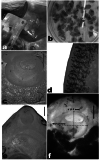Economic losses, morpho-molecular identification, and identity of Fasciola species recovered from Egypt
- PMID: 36457773
- PMCID: PMC9606198
- DOI: 10.1007/s12639-022-01526-x
Economic losses, morpho-molecular identification, and identity of Fasciola species recovered from Egypt
Abstract
A retrospective study to estimate economic losses caused by livers condemnation, due to fascioliasis, of slaughtered cattle and buffaloes in Egypt during the period of 2016-2020, was done. Moreover, a morpho-molecular identification of collected liver flukes from slaughtered animals in municipal abattoirs was conducted. Livers of naturally infected carcasses were obtained from slaughtered animals in Beni-Suef, Cairo and Tanta provinces, Egypt during 2019-2020 for phenotypic characterization of recovered Fasciola species and molecular identification of collected worms using PCR targeting the ITS-1 region. Findings of the retrospective study revealed that percentages of livers condemnation of cattle and buffaloes ranged from 0.79 to 0.66% during the period from 2016 to 2020. The highest percentages were detected in the south Egypt (2.5-6.0%) with the highest economic losses (261850-616300 USD annually). Morphometrically, collected flukes categorized into Fasciola hepatica and Fasciola gigantica. No intermediate forms (Fasciola sp.-like) were detected. Sequencing analysis of ITS-1 PCR products showed that only Fasciola hepatica (26/34) and F. gigantica (8/34) isolates were found, with no intermediate forms, Fasciola sp.-like, could be identified. Currently, Fasciola hepatica was 100% identical with the Egyptian species (LC076196 and JF294998), French species (JF294999), and Iranian species (MF969009 and MK377150). Moreover, the obtained F. gigantica species showed 100% identity with Egyptian ones (LC076125, LC076108 and KX198619), Iranian (KF982047 and MF372919), and other GenBank specimens from Vietnam, Cameroon and India. In conclusion, South Egypt showed the highest economic losses due to fascioliasis, especially Aswan province. Fasciola hepatica was more common than F. gigantica, while the hybrid form was not detected.
Keywords: Egypt; Fasciola gigantica; Fasciola hepatica; ITS-1; Morphometry; PCR; Ruminants.
© Indian Society for Parasitology 2022, Springer Nature or its licensor holds exclusive rights to this article under a publishing agreement with the author(s) or other rightsholder(s); author self-archiving of the accepted manuscript version of this article is solely governed by the terms of such publishing agreement and applicable law.
Conflict of interest statement
Conflict of interestAuthors declare that there is no conflict of interest.
Figures






Similar articles
-
Identity of Fasciola spp. in sheep in Egypt.Parasit Vectors. 2016 Dec 1;9(1):623. doi: 10.1186/s13071-016-1898-2. Parasit Vectors. 2016. PMID: 27906040 Free PMC article.
-
Morphological and molecular characterization of Fasciola isolates from livestock in Golestan province, northern Iran.Vet Med Sci. 2023 Jul;9(4):1824-1832. doi: 10.1002/vms3.1189. Epub 2023 Jun 15. Vet Med Sci. 2023. PMID: 37317979 Free PMC article.
-
Morphological and molecular characterization of Fasciola hepatica and Fasciola gigantica phenotypes from co-endemic localities in Mpumalanga and KwaZulu-Natal provinces of South Africa.Food Waterborne Parasitol. 2021 Feb 3;22:e00114. doi: 10.1016/j.fawpar.2021.e00114. eCollection 2021 Mar. Food Waterborne Parasitol. 2021. PMID: 33681492 Free PMC article.
-
Potential Hybridization of Fasciola hepatica and F. gigantica in Africa-A Scoping Review.Pathogens. 2022 Nov 6;11(11):1303. doi: 10.3390/pathogens11111303. Pathogens. 2022. PMID: 36365054 Free PMC article.
-
Update of fasciolosis-transmitting snails in Egypt (review and comment).J Egypt Soc Parasitol. 2005 Aug;35(2):477-90. J Egypt Soc Parasitol. 2005. PMID: 16083061 Review.
Cited by
-
Diagnosis of fasciolosis antibodies in Brazilian cattle through ELISA employing both native and recombinant antigens.Microbiol Spectr. 2024 May 2;12(5):e0009524. doi: 10.1128/spectrum.00095-24. Epub 2024 Mar 27. Microbiol Spectr. 2024. PMID: 38534120 Free PMC article.
-
Histopathological changes and oxidative stress associated with Fascioliasis in bovines.Trop Anim Health Prod. 2024 Jan 18;56(2):48. doi: 10.1007/s11250-024-03896-1. Trop Anim Health Prod. 2024. PMID: 38236357
-
Artemisia vulgaris anthelmintic activities to ova and adult stages of Fasciola gigantica in vitro.Vet World. 2023 May;16(5):1141-1153. doi: 10.14202/vetworld.2023.1141-1153. Epub 2023 May 30. Vet World. 2023. PMID: 37576776 Free PMC article.
-
Molecular characterization of Fasciola hepatica in endemic regions of Colombia.Front Vet Sci. 2023 Jun 9;10:1171147. doi: 10.3389/fvets.2023.1171147. eCollection 2023. Front Vet Sci. 2023. PMID: 37360412 Free PMC article.
-
First morphometric and molecular characterization of Fasciola spp. in Northwest Tunisia.Parasitol Res. 2023 Nov;122(11):2467-2476. doi: 10.1007/s00436-023-07933-0. Epub 2023 Aug 29. Parasitol Res. 2023. PMID: 37642769
References
-
- Abd El-Aziz OM, Hassanin FS, Shaltout FA, Mohamed OA. Prevalence of some foodborne parasitic affection in slaughtered animals in local Egyptian abattoir. Benha Vet Med J. 2021;40:111–114. doi: 10.21608/bvmj.2021.80316.1432. - DOI
-
- Abdel-Hakeem SS, Omar MAFE. Ovine fascioliasis: environmental epidemiology and meta-analysis of the prevalence, agro-ecological and economic factors in five provinces of the Nile Delta region of Egypt. Damanhour J Vet Sci. 2020;3(1):23–31. doi: 10.5455/djvs.2020.67811. - DOI
-
- Adediran OA, Uwalaka EC. Laboratory breeding of Lymnaea natalensis (Krauss, 1848) intermediate host of Fasciola gigantica (Cobbold, 1856) N Y Sci J. 2013;6(8):55–57.
LinkOut - more resources
Full Text Sources
